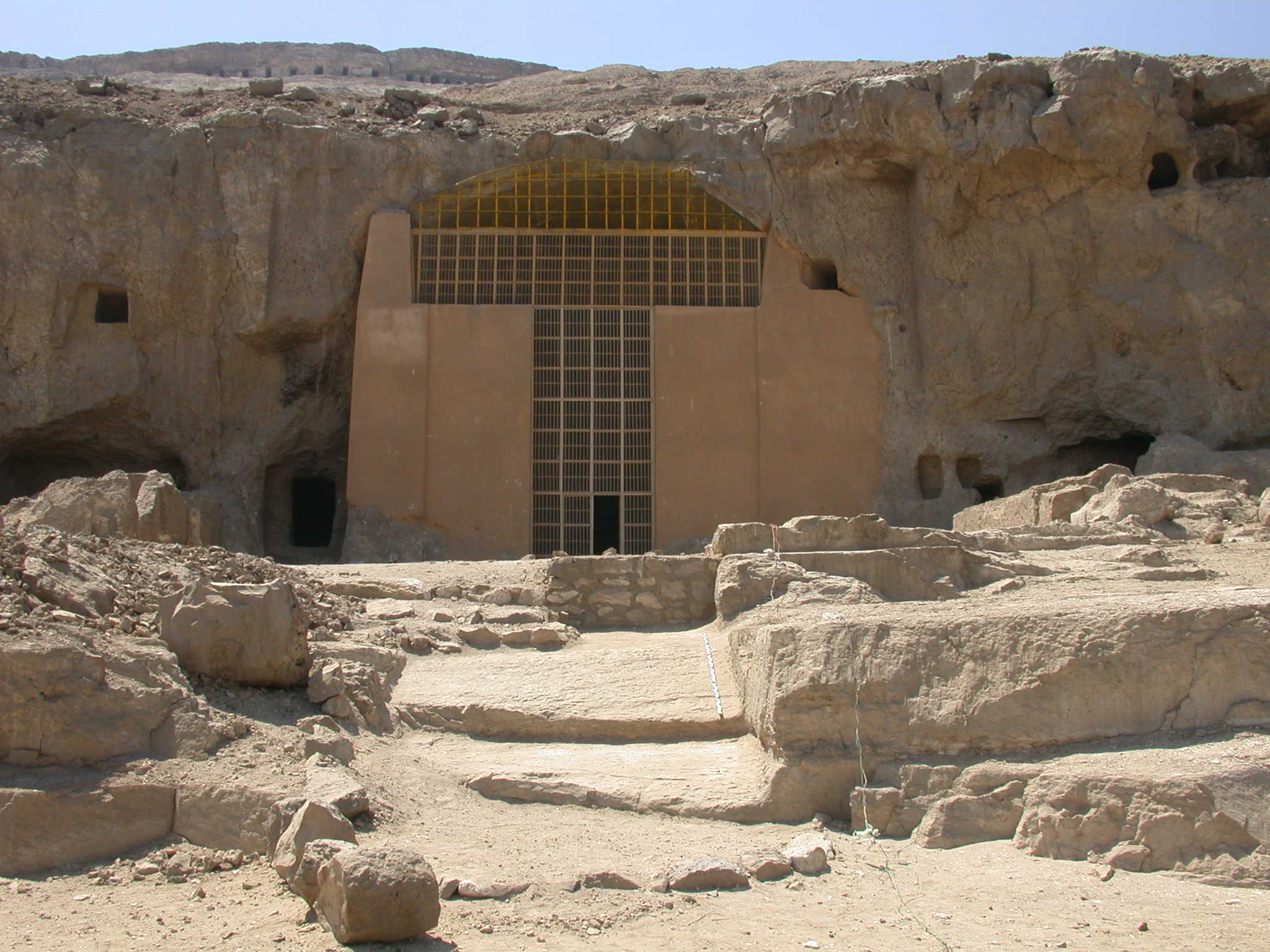
Click here for English version
Click here for Japanese version: 第1号墓 州候ジェファイハピの墓
Grab I (12. Dynastie)
Grab I wurde vom Gaufürsten Djefai-Hapi I. angelegt, der unter Sesostris I. (12. Dynastie) im Amt war. Bei diesem Bau handelt es sich um das größte heute erhaltene Felsgrab eines Privatmannes des Mittleren Reiches in Ägypten. Im Felsen sind noch mehrere Raumfolgen auf einer Länge von ca. 55 m erhalten. Die Räume haben teilweise eine Höhe von über 11 m. Zusätzlich können aufgrund der Grabinschriften, alter Reiseberichte und innerhalb des Asyut Project erfolgter archäologischer Feldforschung eine weitere Raumfolge sowie ein Aufweg und eine über diesem mit dem Grab verbundene, im Fruchtland gelegene Kapelle rekonstruiert werden. Die Ausmaße der monumentalen Grabanlage vergrößern sich dadurch auf eine ursprüngliche Länge von mindestens 120 m. Das Innere der heute noch erhaltenen Raumfolge ist über und über mit Malerei und in Stein gemeißelten Inschriften versehen. Seit 2004 werden erstmals überhaupt Faksimiles dieser Dekoration im Rahmen des Asyut Project erstellt. Insbesondere die Malereien sind bislang gänzlich unbekannt. Die Inschriften hingegen zählen zu den besten Beispielen für die Klassisch-mittelägyptische Sprache (Der Anteil Assiuts am kulturellen Gedächtnis Ägyptens). Dennoch wurden auch sie noch nicht adäquat dokumentiert.
Neben der Aufnahme von Inschriften und Dekoration sowie der Vermessung von Grab I/P10.1 wurde mit der Reinigung des Bereichs der ehemals ersten Halle begonnen. Dabei konnte der Aufweg teilweise freigelegt und sein schon 2004 vermuteter Verlauf ins Fruchtland bestätigt werden. Bei den Arbeiten während der Kampagne 2014 wurden zudem Schächte im Bereich der ersten Halle freigelegt. Sie erfuhren im späten Mittleren Reich/dem Beginn der Zweiten Zwischenzeit eine Nachnutzung, die in Verbindung mit dem Kult des vergöttlichten Djefai-Hapi stehen könnte, dessen „Tempel“ auch in den Dipinti des Neuen Reiches in Grab N13.1 erwähnt wird.
Die umfangreichen Arbeiten ägyptischer Restauratoren betrafen in den vergangenen Jahren die Konsolidierung fragiler Teile der Dekoration und die großflächige Entfernung von Ruß und Schmutz. Dadurch konnte erstmals die aufwendige Dekoration der Decke der großen Querhalle vollständig erkannt und rekonstruiert werden.
Publikation: J. Kahl, Ornamente in Bewegung: Die Deckendekoration der Großen Querhalle im Grab von Djefai-Hapi I. in Assiut,The Asyut Project 6, Wiesbaden 2016.
Tomb I (12th Dynasty)
Tomb I was built by Nomarch Djefai-Hapi I, who was in office during the reign of Sesostris I (12th Dynasty). This construction is the largest preserved rock cut tomb belonging to a private person of the Middle Kingdom in Egypt. A sequence of rooms hewn into the mountain to a distance of 55 m is still standing. The internal height of the rooms reaches more than 11 m. Additionally, based on the tomb inscriptions and other resources such as old travelogues and archaeological fieldwork of the Asyut Project, a further room, a causeway, probably a pylon or an entrance hall, a garden with trees, a pond and a small chapel located in the cultivated land can be reconstructed. The dimension of the monumental tomb layout is therefore at least 120 m greater than the originally supposed length. The interior of the still-preserved sequence of rooms is covered over and over with paintings and stone chiseled inscriptions. Since 2004 facsimiles of the decoration have been made for the first time by the Asyut Project. In particular, the paintings have been totally unknown up to now. Although the inscriptions are among the best examples of classic Middle Egyptian language (The role of Asyut in the cultural memory of Egypt), they were not yet appropriately documented.
Besides recording the inscriptions, decoration and architecture of Tomb I (P10.1), cleaning of the area of the former first hall began. Here, the causeway was partially cleared and its orientation to the cultivated land became visible, thus corroborating a hypothesis already brought forward in 2004. During the fieldwork in 2014, shafts in the area of the first hall were also uncovered. They were reused during the late Middle Kingdom/the beginning of the Second Intermediate Period, which seems to be related to the cult of the deified Djefai-Hapi, whose "temple" was mentioned also in the dipinti of the New Kingdom in Tomb N13.1.
In recent years the extensive work of the Egyptian restorers concerned the strengthening of fragile parts of the decoration and the large-scale removal of soot and dirt. For the first time the elaborate decoration of the ceiling of the Great Transverse Hall was completely recognized and reconstructed.
Publication: J. Kahl, Ornamente in Bewegung: Die Deckendekoration der Großen Querhalle im Grab von Djefai-Hapi I. in Assiut,The Asyut Project 6, Wiesbaden 2016.
